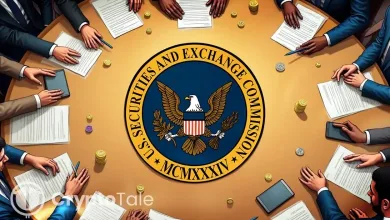SEC’s Crypto Task Force Aims to Modernize Digital Asset Rules

When the U.S. Securities and Exchange Commission (SEC) launched its Crypto Task Force on 21 January 2025, the regulator signaled a profound change in its approach to digital assets. The SEC said the new group, led by Commissioner Hester Pierce, would develop a comprehensive framework for crypto assets.
Acting Chair Mark Uyeda stated that the Task Force aimed to draw clear regulatory lines, craft disclosure frameworks, provide realistic paths to registration, and deploy enforcement resources effectively. This purpose stands in stark contrast to the previous administration’s reliance on litigation, which critics said created confusion and discouraged innovation.
On its website, the SEC cited that the Task Force will work with the Commission staff and the public to chart a new approach to crypto regulation. Its remit includes digital tokens, coins, and protocols, with a focus on distinguishing securities from non‑securities while ensuring investors receive essential information.
It also promised to coordinate its work with Congress, the Commodity Futures Trading Commission (CFTC), and other federal and state agencies. Peirce stressed that industry input would be critical and invited comments via email, roundtables, and public submissions.
The SEC emphasized that its reliance on enforcement to regulate crypto had created an environment hostile to innovation. In a February 4 statement titled “The Journey Begins,” Peirce likened the initiative to a road trip, aiming to make the journey more predictable and less risky. Further, she criticized the SEC’s prior “head‑in‑the‑sand” approach, which relied on enforcement rather than rulemaking, leaving the industry without a clear destination.
Further, the statement outlined ten priorities for the Task Force. Firstly, the agency would determine the status of crypto assets under the securities laws and also identify areas outside the SEC’s jurisdiction, thus encouraging requests for no-action letters to guide firms without litigation.
To address uncertainty surrounding coin and token offerings, Pierce proposed temporary relief that would treat tokens as non‑securities if issuers supplied specified information and accepted the Commission’s jurisdiction. Peirce further added that the Task Force would consider modifying Regulation A and crowdfunding rules to offer viable paths for token registration, and explore updates to the broker‑dealer frameworks so that firms could custody both crypto securities and non‑securities.
Early Moves
A prominent action of the Task Force is to reduce the high‑profile enforcement cases. Earlier, in February, the SEC and Coinbase filed a joint stipulation to dismiss the agency’s lawsuit against the exchange “with prejudice.”
Moreover, in their roundup of February developments, Morrison & Foerster reported that the dismissal acknowledged the Task Force’s launch and noted that the SEC had previously accused Coinbase of operating an unregistered national securities exchange, broker, and clearing agency. Commissioner Peirce issued a statement the same day criticising the SEC’s strategy of “using its enforcement tool to regulate the crypto industry”.
On 10 February 2025, a joint motion for a 60-day litigation was signed by the SEC, three Binance‑related entities, and Binance founder Changpeng Zhao. The motion cited the launch of the Task Force and the possibility of resolution. Later that month, Robinhood announced that the SEC had closed its investigation over the firm, without pursuing any enforcement action. These moves signalled that the regulator intended to halt or slow enforcement cases that focused solely on registration issues while it worked on clearer rules.
Other priorities included collaborating with investment advisers to develop custody solutions, clarifying how lending and staking programs fit within securities laws, and working with staff on exchange‑traded products. The group also planned to address the intersection of crypto with clearing and transfer agent rules, and to consider a cross‑border sandbox for temporary experimentation. Peirce emphasized that these priorities were not exhaustive and invited further submissions and meetings.
As part of its early course corrections, the SEC’s Office of the Chief Accountant rescinded Staff Accounting Bulletin No. 121 and replaced it with SAB 122, effective 30 January 2025. The new bulletin rescinds guidance on accounting for obligations to safeguard crypto assets and instructs entities to apply existing contingency recognition standards under U.S. GAAP and IFRS.
The staff reminded entities to provide clear disclosures about obligations to protect crypto assets, emphasizing that existing requirements under Regulation S‑K and relevant accounting standards still apply. This move removed a controversial rule that had required crypto custodians to record customer holdings as liabilities on their balance sheets, signaling the SEC’s willingness to revisit guidance that industry participants criticised as onerous.
The SEC also reorganised its enforcement infrastructure. On 20 February 2025, it announced the creation of a Cyber and Emerging Technologies Unit (CETU) within the Division of Enforcement. The roughly 30‑member unit replaced the Crypto Assets and Cyber Unit and will focus on combating cyber‑related misconduct. Its priority areas include fraud involving emerging technologies such as artificial intelligence, fraud perpetrated via social media or the dark web, hacking to obtain material nonpublic information, retail account takeovers, fraud involving blockchain and crypto assets, compliance with cybersecurity rules, and fraudulent disclosure relating to cybersecurity. The reorganisation reflects the SEC’s intent to separate its enforcement focus on cybercrime from its policy work on digital asset regulation.
Related: SEC & CFTC Propose 24/7 Crypto Trading for U.S. Markets
Engagement, Roundtables, and Public Feedback
From the start, the Task Force emphasised engagement with investors, entrepreneurs, and academics, dedicating an email address for submissions on its website. The SEC’s Crypto Task Force page noted that the members look forward to engaging with the public through meetings, information requests, and roundtable discussions, and that the group will coordinate with regulators across government. The site also explained that the task force seeks to provide clarity on the application of federal securities laws to crypto assets and to recommend practical policy measures that foster innovation.
The task force began hosting a series of public roundtables dubbed the “Spring Sprint Toward Crypto Clarity.” The first session on 21 March 2025, titled “How We Got Here and How We Get Out – Defining Security Status,” brought together legal scholars and market participants to discuss when crypto assets are securities. On 11 April 2025, the task force convened “Between a Block and a Hard Place: Tailoring Regulation for Crypto Trading,” focusing on how to adapt trading rules to digital assets. Two weeks later, on 25 April 2025, a roundtable titled “Know Your Custodian: Key Considerations for Crypto Custody” examined how to safeguard digital assets and ensure robust custody practices.
The engagement continued into the summer. On 12 May 2025, the task force held a roundtable on “Tokenization – Moving Assets On‑Chain: Where Traditional Finance and DeFi Meet,” exploring how tokenized securities and decentralised exchanges could coexist. On 9 June 2025, it convened “DeFi and the American Spirit,” a session that looked at decentralized finance’s potential and the regulatory challenges it poses. These events provided a forum for stakeholders to give feedback and allowed the SEC to test ideas before formal rulemaking. The transcripts and recordings were made available on the SEC’s website, and the agency said it would continue the roundtable series later in the year.
In May, the annual SEC Speaks conference offered further insights. Vedder Price’s summary of the event noted that Chair Paul Atkins described a “new day” at the SEC and directed staff to promote innovation rather than stifle it. Atkins highlighted recent innovations in the crypto industry and instructed staff to engage transparently with the public, draft rule proposals, and explore allowing registrants to trade securities and non‑securities under one roof.
Commissioner Mark Uyeda said the Commission’s recent course corrections included dismissing crypto enforcement actions where the only violation was failure to register, replacing Staff Accounting Bulletin 121, holding roundtables, and rescinding staff legal guidance.
Uyeda praised the move away from regulation by enforcement and emphasised the need to provide assurances that it would not be used as a policymaking tool. Commissioner Caroline Crenshaw warned, however, that the agency was “chipping away” at decades of regulatory work and cautioned that Main Street investors could suffer if deregulatory efforts go too far.
Project Crypto and Cross‑Agency Collaboration
By mid‑2025, the task force’s work began to intersect with broader initiatives at the SEC and across the federal government. On 31 July 2025, SEC Chairman Paul Atkins announced “Project Crypto,” a Commission‑wide effort to modernise securities rules so that U.S. financial markets can operate “on‑chain.”
A Sidley Austin analysis of the speech explained that Atkins instructed staff to use interpretive and exemptive relief to ensure existing rules do not smother innovations. Project Crypto’s key components include clarifying when crypto assets qualify as securities, stablecoins, digital commodities, or collectibles; promoting purpose‑fit disclosures and safe harbours for token distribution; facilitating the tokenisation of stocks and bonds, and allowing DeFi protocols to host trading without central intermediaries.
It also seeks to modernise custody rules, allow broker‑dealers to trade non‑security crypto assets alongside securities on “super‑app” platforms, and streamline licensing so registrants are not subject to duplicative regulation. Atkins floated the idea of an “innovation exemption” to permit novel business models without full compliance, provided they meet principles‑based conditions.
The task force’s collaborative ethos was evident on 2 September 2025 when SEC and CFTC staff issued a joint statement on the trading of particular spot crypto‑asset products. The statement clarified that SEC‑ and CFTC‑registered exchanges are not prohibited from facilitating trading in certain spot commodity products.
Atkins hailed the announcement as a significant step toward bringing innovation back to America and stated that market participants should have the freedom to choose where they trade spot crypto assets and pledged to work with the CFTC to ensure regulatory frameworks support innovation and competition. CFTC Acting Chair Caroline Pham said the joint statement marked the end of mixed signals and promised collaboration under President Trump’s approach to make America the “crypto capital of the world”.
Related: SEC, CFTC Unite to Allow Spot Crypto Trading on U.S. Platforms
Ongoing Criticism
In an August 5 statement, Commissioner Caroline Crenshaw argued that staff guidance on liquid staking rested on shaky assumptions and lacked clarity, thus risking harm to innovation. Her remarks highlighted tensions within the Commission over how quickly to loosen constraints.
Despite the concerns, the Task Force continues its work, signaling the SEC’s intent to replace enforcement-driven policies with clear rules and to reshape crypto regulations for a better future.





